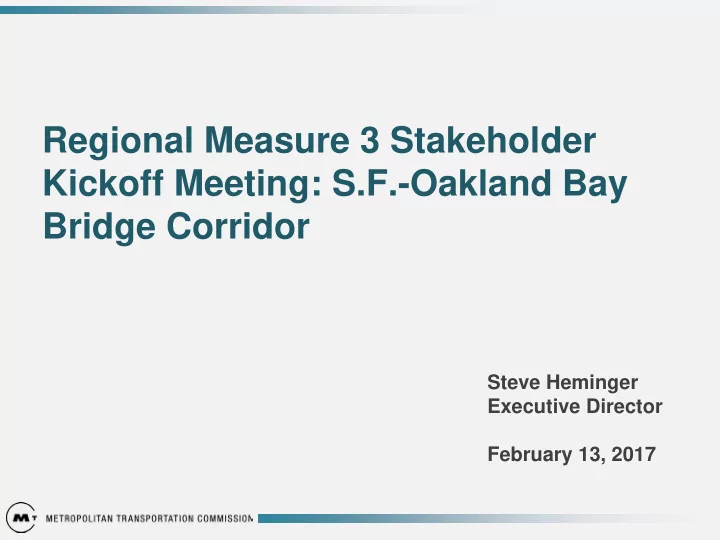

Regional Measure 3 Stakeholder Kickoff Meeting: S.F.-Oakland Bay Bridge Corridor Steve Heminger Executive Director February 13, 2017
BATA’s Seven-Bridge System Carquinez Bridge Opened 1927, 1958 and 2003 Antioch Bridge Benicia-Martinez Bridge Opened 1926 Opened 1962, Widened 1991 Replaced 1978 Second span opened in 2007 Richmond-San Rafael Bridge San Mateo-Hayward Bridge Opened 1956 Opened 1929, Replaced 1967, Widened 2003 San Francisco-Oakland Bay Bridge Opened 1936 New East Span Dumbarton Bridge Opened September 2013 Opened 1927 Replaced 1984
Advantage of Bridge Tolls Regional by nature ̶ span counties Flexible by mode ̶ road, transit, bikes Flexible by use ̶ capital or operating Low borrowing costs ̶ AA-rated credit Fees not taxes ̶ majority vote and manage demand
Bridge Toll History and Revenue Toll Rate Increases Approval Regional Measure 1 (1988) $1 Voters Seismic Surcharge (1998) $1 Legislature Regional Measure 2 (2004) $1 Voters Seismic Surcharge (2007) $1 BATA Enterprise Increase (2010) $1 BATA TOTAL AUTO TOLL (2017) $5 $714 M Multi-axle vehicles pay an axle-based toll San Francisco-Oakland Bay Bridge toll varies on weekdays during the commute: $6 peak/$4 off-peak, $5 on weekends.
Toll Rate Comparisons Facility Standard Auto Carpool Toll Toll BATA Bridges $5.00 $2.50 $7.50/$6.50 Golden Gate Bridge $4.50 Plate/FasTrak MTA Verrazano $3.08** $11.08*/$16.00 Narrows Bridge E-ZPass/Cash Port Authority of New $10.50/$12.50/$15.00 $6.50 York/New Jersey Off-Peak/Peak/Cash (Bridges/Tunnels) * Odd toll rate results from EZ-pass electronic discount rate **Average rate based on 24 trips
Regional Measure 1 (1988 – Lockyer ) Funds Projects (mil.) New Benicia Bridge $1,200 Carquinez Bridge $518 Replacement New I-880/92 Interchange $235 San Mateo-Hayward $210 Bridge Widening Richmond-San Rafael $117 Bayfront Expressway Bridge Trestle & Deck Bayfront Expressway $36 Widening Other Projects $90 Total $2,406
Regional Measure 2 (2004 – Perata ) Funds Projects (mil.) BART Warm Spring $304 Extension* Transbay Transit Center* $353 E-BART/Highway 4 Widening $269 Oakland Airport Connector* $146 I-80 HOV Lanes/Truck Scales* $123 SMART Rail Extension $82 AC Transit Rapid Bus $78 Transit Center Upgrades & $65 New Buses BART Tube Seismic Retrofit $34 Regional Ferry Vessels $46 Total Capital Program $1,515 Note: Not a comprehensive list of RM 2 expenditure plan. Projects marked with asterisk received other toll revenue in addition to RM2.
Election Results: Regional Measures 1 and 2 Regional Measure 1 Regional Measure 2 (1988) (2004) Yes No Yes No Alameda 71% 29% 56% 44% Contra Costa 68% 32% 51% 49% Marin 76% 24% 64% 36% San Francisco 69% 31% 69% 31% San Mateo 74% 26% 55% 45% Santa Clara 71% 29% 60% 40% Solano 58% 42% 41% 59% TOTAL 70% 30% 57% 43%
MTC Draft Principles for Regional Measure 3 Bridge Nexus State of Good Repair Ensure all projects benefit toll payers Invest in projects that help restore in the vicinity of the Bay Area’s seven transportation infrastructure in the state-owned toll bridges bridge corridors Regional Prosperity Technology Invest in projects that will sustain the Invest in technology to optimize region’s strong economy by roadway capacity enhancing travel options and Freight improving mobility Improve the mobility, safety and Sustainability environmental impact of freight Ensure all projects are consistent Resiliency with Plan Bay Area’s 2040 focused Invest in resilient bridges, including growth and greenhouse gas addressing sea level rise reduction strategy
Toll Increase Revenue Options and Trade-Offs Annual Capital Funding Toll Surcharge Revenue Available Amount ($ M) (25-year bond) $1 $127 $1.7 billion $2 $254 $3.3 billion $3 $381 $5.0 billion Share of Funds Annual Total Capital for Operations Operating Funding Budget ($3 Toll Option) ($M) 0% — $5.0 billion 5% $19 $4.7 billion 10% $37 $4.5 billion 15% $56 $4.2 billion 20% $75 $4.0 billion
Share of Toll Revenue by County of Residence 9% 2% Alameda, 31% 31% Contra Costa, 18% 14% Marin, 4% Napa, 2% San Francisco, 10% 2% San Mateo, 8% 8% Santa Clara, 2% Solano, 14% Sonoma, 2% 10% Out of Region, 9% 18% 2% 4% Source: 2015 MTC FasTrak Data – Average typical weekday transactions by county of billing address
Share of Voters by County 7% 5% 22% Alameda, 22% Contra Costa, 15% Marin, 4% 22% Napa, 2% San Francisco, 13% San Mateo, 10% 15% Santa Clara, 22% Solano, 6% Sonoma, 7% 10% 4% 2% 13% Source: 2016 California Secretary of State Report of Registration (registered voters by county as of 10/24/2016)
Share of Toll Revenue by Bridge 2% SF - Oakland Bay Bridge, 32% 14% Benicia-Martinez, 16% 32% Carquinez, 17% Dumbarton, 8% 11% Richmond-San Rafael, 11% San Mateo - Hayward, 14% 8% Antioch, 2% 16% 17% Source: FY 2016 Toll Revenues Collected by Bridge, MTC Comprehensive Annual Financial Report, June 30, 2016
RM 3 Expenditure Plan Concepts Bridge rehabilitation Express Lane corridors Freight Bay Trail BART expansion cars Transit access improvements
Key Policy Questions Should congestion pricing be expanded on the Bay Bridge and/or considered on other bridges? What kinds of projects should be considered for funding? Should a FasTrak discount be authorized? Should some toll revenue be used for annual operating purposes, and if so, how much? Should projects and programs be enumerated in legislation, determined through a regionally-based expenditure plan, or some combination thereof?
Plan Bay Area Assumptions Plan Bay Area 2013 assumed $2.7 billion total in new anticipated bridge tolls through 2040, including for the following projects/categories: Transbay Transit Center/Caltrain Downtown Extension ($300 M) Highway & Bridge Fix-it-First ($900 M) Transit Fix-it-First ($1 B) Draft Plan Bay Area 2040 assumes $4 billion in capital funding over 23 years for programs & projects, including: Transbay Transit Center/Caltrain Downtown Extension ($300 M) Transit preservation ($980 M) BART Transbay Core Capacity ($450 M) Goods movement ($380 M) Regional & Local Bridges ($250 M)
Recommend
More recommend